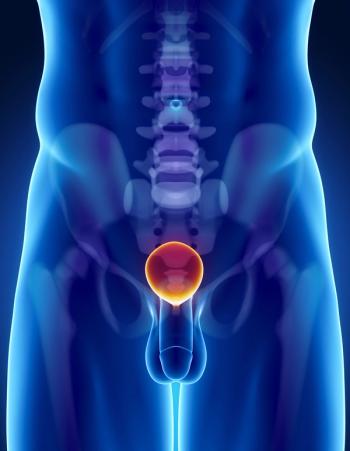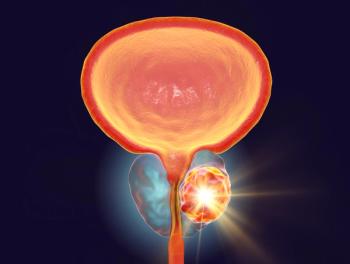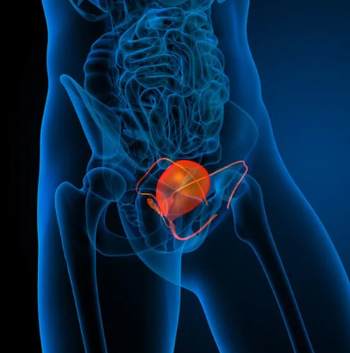
Oncology NEWS International
- Oncology NEWS International Vol 10 No 1
- Volume 10
- Issue 1
Prostate Cancer Patients Tolerate Higher 3D Conformal RT Doses
BOSTON-Raising 3D conformal radiation therapy doses for localized prostate cancer produced far less toxicity than expected in a nine-center cooperative study reported at the annual meeting of the American Society for Therapeutic Radiology and Oncology (ASTRO).
BOSTONRaising 3D conformal radiation therapy doses for localized prostate cancer produced far less toxicity than expected in a nine-center cooperative study reported at the annual meeting of the American Society for Therapeutic Radiology and Oncology (ASTRO).
Jeff M. Michalski, MD, of Washington University School of Medicine, St. Louis, said that acute toxicity was "remarkably low" and late toxicity also was low, compared to historical data from trials conducted in the 1970s. "Despite higher radiation doses, the tolerance is significantly better than in older trials with older techniques," he told ONI.
He noted that the reference doses were nearly 1,000 cGy higher in the phase I/II trial (RTOG 9406) than in the two earlier studies (RTOG 7506 and RTOG 7706). The patients tolerated the first dose level tested, 68.4 Gy, so well, he said, that the investigators received permission to test at a second level, 73.8 Gy. This also resulted in a dramatically lower rate of observed complications than expected.
From 1994 to 1999, 424 patients with localized prostate cancer were entered into the trial. All were nonmetastastic with PSAs less than 70 ng/mL.
Initially, patients receiving neoadju-vant hormonal therapy were excluded, Dr. Michalski said, but patients receiving neoadjuvant hormonal therapy for 3 to 6 months were accepted after its use was supported in other trials. Patients whose prognosis was so favorable that dose escalation would be inappropriate were excluded. The patients were separated into three groups:
Group 1 had T1-2 tumors with a seminal vesicle invasion (SVI) risk of less than 15%. Patients received the minimum doses of 68.4 Gy or 73.8 Gy to the planning target volume, including a margin of 5 to 10 mm around the prostate.
Group 2 had the same tumor staging with SVI risk at or greater than 15%. Patients in this group received 3D conformal radiation therapy to the prostate and seminal vesicle plus an initial planning target volume margin to a dose of 55.8 Gy. This was followed by a reduction in treatment volume to the prostate plus a second planning target volume margin to 68.4 Gy or 73.8 Gy.
Group 3 patients had T3 tumors. The prostate and seminal vesicle and planning treatment volume margin was treated to 68.4 Gy or 73.8 Gy with no reduction in treatment volume.
Toxicity
Acute toxicity was very low, with grade 3 toxicity less than 1% for group 1, less than 3% for group 2, and less than 10% for group 3. The highest incidence occurred in group 3 patients treated to 73.8 Gy (7% grade 3 and 3% grade 4).
Late toxicity was low compared to the historical trials. Only two patients had grade 3 bladder toxicity, and no other late grade 3 toxicities were reported. Grade 2 toxicities ranged from 16% to 21% in groups 1 and 2, and from 25% to 31% in group 3.
Patients with higher-stage disease had a higher rate of bladder and rectal complications. Dr. Michalski said this was probably because larger volumes of the bladder and rectum were treated. Patients who received neoadjuvant hormonal therapy also had a higher rate of complications, he said, speculating that this might be due to the difficulty of "planning radiation on a shrinking target." This finding will need to be confirmed with more follow-up, he added.
The study is ongoing, and the investigators will do dose-volume analysis of the bladder and rectum to predict the risk of grade 2 and greater acute and late toxicities. "We plan to establish maximum tolerated vs standard dose," Dr. Michalski said.
Articles in this issue
almost 25 years ago
ODAC Recommends Campath for FDA Approval for Refractory CLLalmost 25 years ago
‘IrinoGem’ Active and Well Tolerated in Pancreatic Canceralmost 25 years ago
STI571 Studies Help Validate Molecular Targeting in CMLalmost 25 years ago
Outpatient Mylotarg Therapy Cuts Costs in Relapsed AMLalmost 25 years ago
STI571 Proves Effective in Patients With Interferon-Failure CMLalmost 25 years ago
IP6 (Phytic Acid) Inhibits Breast Cancer in Animalsalmost 25 years ago
Adjuvant Therapy Beneficial in Early, Node-Negative Breast Canceralmost 25 years ago
Medicare Increases Payment Rates for Most Physiciansalmost 25 years ago
Update on High-Dose Consolidation Therapy in Breast Canceralmost 25 years ago
Lessons Learned From Large Lung Cancer Screening ProgramNewsletter
Stay up to date on recent advances in the multidisciplinary approach to cancer.

















































































